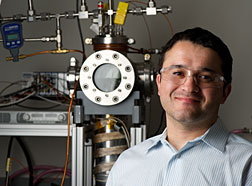- Number 370 |
- August 27, 2012
NREL’s Moreno makes car parts cool

Gilbert Moreno.
Gilbert Moreno was about 8 when he started “tearing apart electric motors and putting them back together” in his backyard in El Paso, Texas.
His dad, a laborer at a copper refinery, and his mother, who had a fifth-grade education, encouraged his interest and made sure he always got his homework done.
Now, Moreno, the first person in his family with a college education, is a mechanical engineer at DOE’s National Renewable Energy Laboratory (NREL), doing groundbreaking work that has vendors for the big auto manufacturers putting him on their speed dials.
His unique approach to two-phase cooling shows that thermal resistance in electronics can be slashed by more than half. Modern electric and hybrid vehicles have several electronic power devices under the hood and elsewhere. Efficiently cooling the underside of those devices can lead to automobiles that require fewer silicon devices, weigh less, cost less and get more miles per gallon.
“I just always wanted to understand how things worked,” Moreno said. “I was always making my own little motorized cars.”
By his late elementary school years, a test confirmed his aptitude for learning and he was recommended for a high-performing middle school, which he declined so he could remain with his friends.
He said three middle-school math teachers ignited a passion for math to pair with his love for engineering. “My dad has always been a very smart person, and he was always able to help me with math, even though he didn’t have the formal education,” Moreno, 34, said. “My parents always emphasized the importance of education to my sisters and me, but they didn’t really have a sense of what college entailed.”
At 15, he began working for his uncle, pushing wheelbarrows of wet concrete to make sidewalks and driveways. The work in 100-plus-degree heat sparked an interest in indoor work.
“I didn’t really have guidance from high school counselors about college, but my senior year I applied to the local university, University of Texas at El Paso, and was accepted to study mechanical engineering, Moreno said.
Moreno worked his way through his undergraduate years as a busboy, dishwasher, cook, and then lead cook, at a Steak & Ale, grilling hundreds of meals each night. He also was an orientation facilitator for incoming freshmen and, during his last semester, an oil refinery technician, assessing the water quality at cooling towers.
His first job out of college was as an engineer at Lockheed Martin Missiles and Fire Control in Grand Prairie, Texas. He earned a Master’s of Science (2005) and a Ph.D. (2009) at the University of Texas at Arlington.
His graduate research focused on a fundamental study of two-phase heat transfer using surface enhancement techniques and nano-fluids.
As he completed his doctorate, he accepted a position at NREL, where he now is a thermal engineer conducting research into the thermal management of automotive power electronics and electric motors in hybrid and electric vehicles. Moreno is the principal investigator on the $450,000 project “Two-phase Cooling Technology for Power Electronics with Novel Coolants.” He also supports four other DOE technical projects.
In the two-phase cooling approach, a liquid is boiled into a vapor as a way of absorbing heat. The better the cooling, the fewer devices needed, and the lower the potential cost of the vehicle.
Moreno’s approach involves circulating a refrigerant through vapor pressure and gravity, assisted by wicking structures, which eliminates the need for a pump.
The two-phase approach to cooling electronic devices has been used in the transportation sector before, primarily with trains in Europe, but never in automobiles before Moreno’s work at NREL.
He works in NREL’s Advanced Power Electronics Lab, these days characterizing the boiling heat-transfer performance of new refrigerants with a high-pressure two-phase cooling vessel.
“I like being in the lab,” Moreno said. “Running experiments, generating data. You hit road blocks that slows things down … but when you fix them, there’s a definite satisfaction in that.”
“I have rarely seen such talent, enthusiasm, drive and humility in one person,” Robert B. Farrington, group manager of the Advanced Vehicle Group at NREL, said of Moreno. “He works at an incredible rate and produces results that industry needs and values. He does everything: from conceiving new experiments, designing and fabricating them, to operating and analyzing data from them. His skills are amazing and combine the rare talent of both modeling and experimental expertise.”
Farrington added that Moreno’s research led to and strengthened NREL’s collaborations with industry, including 3M, Wolverine Tube Inc., GE and Delphi on developing and evaluating surface enhancements for increased heat transfer. His experimental results showing a multi-fold increase in the convective heat transfer coefficient caught the attention of industry.
Sreekant Narumanchi, principal engineer and researcher in NREL’s Advanced Power Electronics Laboratory, said Moreno’s technical paper was “the first to thoroughly characterize the two-phase performance of a new refrigerant that likely will replace the current refrigerant in automobiles.” Moreno also has done novel work with micro-structured surfaces, contributing new understanding to the heat-transfer literature, Narumanchi said.
Moreno, who usually shuns the limelight, gives much of the credit to his parents, who made sure that all their kids got college educations.
When he’s not mountain biking, extracting dinosaur fossils, or finding better ways to cool electronics, he is talking up his siblings.
“My older sister has her master’s in speech pathology and my younger sister has a degree in education,” he said. “Education is an important value in my family.”Submitted by DOE's National Renewable Energy Laboratory
